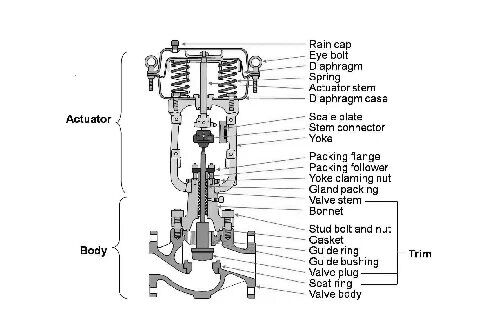How to Understand Pneumatic Single Seated Control Valves
On this page
Pneumatic single seated control valves are among the most commonly used pneumatic control valves in automated production control. Powered by compressed air, they regulate the flow of media within pipelines in accordance with pressure signals from the control system, thereby facilitating the automation of production control processes. This article provides a detailed overview of the working principle, control methods, and structural features of pneumatic single seated control valves.
The working principle of pneumatic single seated control valves is simple yet efficient. The control system sends a current signal (typically 4-20mA) to the valve positioner. The valve positioner converts this current signal into an air pressure signal, usually ranging from 20-100KPa, 40-200KPa, or 80-240KPa, and transmits it to the pneumatic actuator. The pneumatic actuator utilizes the received air pressure signal to control the valve opening, thereby regulating the flow of media. The feedback rod of the positioner is connected to the valve's movement, allowing real-time feedback signals to be sent to the control system for accurate valve positioning.
Pneumatic single seated control valves are primarily categorized into two control methods: regulating and regulating-closing. Regulating valves prioritize the regulation process and offer more flexibility without requiring strict closure, whereas regulating-closing valves not only regulate flow but also maintain good sealing when closed to minimize leakage.
The structural design of pneumatic single seated control valves is intricate, comprising main components such as the valve body, bonnet, seat, plug, stem, guide, packing, and bonnet nut. Compared to double seated and sleeve control valves, pneumatic single seated control valves have only one sealing line, resulting in lower leakage. However, in high-pressure and large-diameter applications, the plug faces significant unbalanced forces, necessitating coordination with piston-type pneumatic actuators and valve positioners.
Additionally, depending on different working environments and media characteristics, pneumatic single seated control valves can choose different types of bonnets, including standard, high-temperature, low-temperature, and bellows-sealed types. Furthermore, various accessories such as valve positioners, filter regulators, handwheel mechanisms, positioners, quick exhaust valves, and solenoid valves can be equipped to meet diverse application requirements.
In conclusion, pneumatic single seated control valves play an irreplaceable role in industrial automation control systems due to their reliable working principle, flexible control methods, and superior structural features. A thorough understanding of their principles and characteristics contributes to their better application across various engineering fields, enhancing system stability and reliability.

